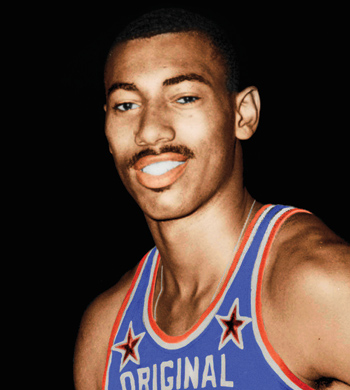The Seven-Foot Sophomore from Philadelphia
Basketball great Wilt Chamberlain scored his 25,000th NBA point 50 years ago today while playing with the Philadelphia 76ers. The seven-foot-one athlete was the first to do so, then he was the first to reach 30,000 points years later. Expectations were always high for “Wilt the Stilt,” ever since he started dominating the game in high school.
Jimmy Breslin wrote about Chamberlain for the Post in 1956 when the latter was a sophomore at University of Kansas. A professional career was assumed to be in the works (“Can Basketball Survive Chamberlain?”), and Breslin described the Stilt’s moves like the young player was capable of magic: “The Stilt drove to the top of the keyhole—or foul circle—and went up for what appeared to be a one- handed jump shot. But he didn’t come down. He kept floating through the air, did a complete twist, so that his back was to the basket, shoved his arm behind him, rotated it in helicopter style and dunked the ball in the net. He landed somewhere behind the basket.”
Chamberlain’s high school basketball career was riddled with visits and calls from recruiters from all over the country, and he was flown to myriad colleges throughout his teen years to see them for himself. He had standards for his post-secondary education, though, that included a history of racial tolerance:
‘When I went to Dayton,’ he recalls, ‘they had me eat my meals in a hotel room. When I figured out why later on, I crossed them off my list. The first time I went to Kansas, the Missouri coach’ — Wilbur Stalcup — ‘met me at the airport—he was kind of cutting in — and asked me if I wanted to be the first Negro to play at his school. I told him no. Same as I told Oklahoma A. and M. And I crossed off a lot of other schools because they never had gone in for colored athletes.’
University of Kansas seemed to be ahead of the curve in 1956, with integrated theaters and hotels. Still, Chamberlain made his terms clear: “‘I want to do my race some good,’ he said. ‘If I get Jim Crowed, I’ll pack my bags and leave,’ he often told Kansas officials.”
His performance with the KU Jayhawks was exceptional and record-breaking, due both to his size and rare skill: “There have been other seven-foot boys in college basketball. Rosters this season list numerous men only an inch or two shorter. But the college basketball player over six-six normally leaves much to be desired in the way of coordination, speed and stamina.” According to Breslin, Chamberlain could reach up to nine feet, six inches standing, and he could jump to twelve-six. That rendered a 10-foot basket a fairly easy target.
Still, Chamberlain was never able to bring home an NCAA championship for the Jayhawks. In 1957, the team was narrowly defeated by North Carolina for the title in a game that Chamberlain’s biographer Robert Cherry called the most devastating loss of his career.
The Stilt went on to an illustrious career with the Harlem Globetrotters, the Warriors, the 76ers, and the Lakers. In 1962, he played his famous 100-point game with the Philadelphia Warriors.
Currently, Chamberlain stands in fifth place of NBA career points leaders. At the top is Kareem Abdul-Jabbar, and closely behind Chamberlain are Dirk Nowitzki and LeBron James.
Celebrity Encounters: Wilt Chamberlain

In 1962, I became chairman and general partner of the San Francisco Warriors, later to become the Golden State Warriors. The team was awful, but it did have 7’1″ “Wilt the Stilt” Chamberlain, the greatest player of all time as far as I’m concerned. Wilt and I became good friends. I owned harness horses in those days, and he loved to gamble, so he became my partner on several horses. Once, while at Roosevelt Raceway in New York to watch one of our horses race, he pulled out a huge stack of $100 bills, peeled off five or six, and handed them to a friend with betting instructions.
I pointed to the roll. “Hey,” I said, “put that away.”
“Why?” he asked.
“Someone’s liable to hit you over the head and grab that,”
I joked.
“Anyone who wants to hit me over the head is gonna need a ladder,” he snapped back. “If I see someone coming at me with a ladder, I’ll yell for help.”
–Matty Simmons
In our March/April 2016 issue, Simmons wrote “The Day Cash Died” about being one of the three men who invented the credit card and formed The Diners Club, the first credit card company.
This article is featured in the March/April 2017 issue of The Saturday Evening Post. Subscribe to the magazine for more art, inspiring stories, fiction, humor, and features from our archives.